History of agriculture
| Agriculture |
|---|
 |
|
|
| Rural area |
|---|
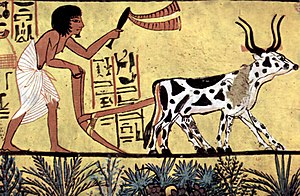
Agriculture began independently in different parts of the globe, and included a diverse range of taxa. At least eleven separate regions of the Old and New World were involved as independent centers of origin. The development of agriculture about 12,000 years ago changed the way humans lived. They switched from nomadic hunter-gatherer lifestyles to permanent settlements and farming.[1]
Wild grains were collected and eaten from at least 104,000 years ago.[2] However, domestication did not occur until much later. The earliest evidence of small-scale cultivation of edible grasses is from around 21,000 BC with the Ohalo II people on the shores of the Sea of Galilee.[3] By around 9500 BC, the eight Neolithic founder crops – emmer wheat, einkorn wheat, hulled barley, peas, lentils, bitter vetch, chickpeas, and flax – were cultivated in the Levant.[4] Rye may have been cultivated earlier, but this claim remains controversial.[5] Regardless, rye's spread from Southwest Asia to the Atlantic was independent of the Neolithic founder crop package.[6] Rice was domesticated in China by 6200 BC[7] with earliest known cultivation from 5700 BC, followed by mung, soy and azuki beans. Rice was also independently domesticated in West Africa and cultivated by 1000 BC.[8][9] Pigs were domesticated in Mesopotamia around 11,000 years ago, followed by sheep. Cattle were domesticated from the wild aurochs in the areas of modern Turkey and India around 8500 BC. Camels were domesticated late, perhaps around 3000 BC.
In subsaharan Africa, sorghum was domesticated in the Sahel region of Africa by 3000 BC, along with pearl millet by 2000 BC.[10][11] Yams were domesticated in several distinct locations, including West Africa (unknown date), and cowpeas by 2500 BC.[12][13] Rice (African rice) was also independently domesticated in West Africa and cultivated by 1000 BC.[8][9] Teff and likely finger millet were domesticated in Ethiopia by 3000 BC, along with noog, ensete, and coffee.[14][15] Other plant foods domesticated in Africa include watermelon, okra, tamarind and black eyed peas, along with tree crops such as the kola nut and oil palm.[16] Plantains were cultivated in Africa by 3000 BC and bananas by 1500 BC.[17][18] The helmeted guineafowl was domesticated in West Africa.[19] Sanga cattle was likely also domesticated in North-East Africa, around 7000 BC, and later crossbred with other species.[20][21]
In South America, agriculture began as early as 9000 BC, starting with the cultivation of several species of plants that later became only minor crops. In the Andes of South America, the potato was domesticated between 8000 BC and 5000 BC, along with beans, squash, tomatoes, peanuts, coca, llamas, alpacas, and guinea pigs. Cassava was domesticated in the Amazon Basin no later than 7000 BC. Maize (Zea mays) found its way to South America from Mesoamerica, where wild teosinte was domesticated about 7000 BC and selectively bred to become domestic maize. Cotton was domesticated in Peru by 4200 BC; another species of cotton was domesticated in Mesoamerica and became by far the most important species of cotton in the textile industry in modern times.[22] Evidence of agriculture in the Eastern United States dates to about 3000 BCE. Several plants were cultivated, later to be replaced by the Three Sisters cultivation of maize, squash, and beans.
Sugarcane and some root vegetables were domesticated in New Guinea around 7000 BC. Bananas were cultivated and hybridized in the same period in Papua New Guinea. In Australia, agriculture was invented at a currently unspecified period, with the oldest eel traps of Budj Bim dating to 6,600 BC[23] and the deployment of several crops ranging from yams[24] to bananas.[25]
The Bronze Age, from c. 3300 BC, witnessed the intensification of agriculture in civilizations such as Mesopotamian Sumer, ancient Egypt, ancient Sudan, the Indus Valley civilisation of the Indian subcontinent, ancient China, and ancient Greece. From 100 BC to 1600 AD, world population continued to grow along with land use, as evidenced by the rapid increase in methane emissions from cattle and the cultivation of rice.[26] During the Iron Age and era of classical antiquity, the expansion of ancient Rome, both the Republic and then the Empire, throughout the ancient Mediterranean and Western Europe built upon existing systems of agriculture while also establishing the manorial system that became a bedrock of medieval agriculture. In the Middle Ages, both in Europe and in the Islamic world, agriculture was transformed with improved techniques and the diffusion of crop plants, including the introduction of sugar, rice, cotton and fruit trees such as the orange to Europe by way of Al-Andalus. After the voyages of Christopher Columbus in 1492, the Columbian exchange brought New World crops such as maize, potatoes, tomatoes, sweet potatoes, and manioc to Europe, and Old World crops such as wheat, barley, rice, and turnips, and livestock including horses, cattle, sheep, and goats to the Americas.
Irrigation, crop rotation, and fertilizers were introduced soon after the Neolithic Revolution and developed much further in the past 200 years, starting with the British Agricultural Revolution. Since 1900, agriculture in the developed nations, and to a lesser extent in the developing world, has seen large rises in productivity as human labour has been replaced by mechanization, and assisted by synthetic fertilizers, pesticides, and selective breeding. The Haber-Bosch process allowed the synthesis of ammonium nitrate fertilizer on an industrial scale, greatly increasing crop yields. Modern agriculture has raised social, political, and environmental issues including overpopulation, water pollution, biofuels, genetically modified organisms, tariffs and farm subsidies. In response, organic farming developed in the twentieth century as an alternative to the use of synthetic pesticides.
Origins
[edit]Origin hypotheses
[edit]
Scholars have developed a number of hypotheses to explain the historical origins of agriculture. Studies of the transition from hunter-gatherer to agricultural societies indicate an antecedent period of intensification and increasing sedentism; examples are the Natufian culture in the Levant, and the Early Chinese Neolithic in China. Current models indicate that wild stands that had been harvested previously started to be planted, but were not immediately domesticated.[27][28]
Localised climate change is the favoured explanation for the origins of agriculture in the Levant.[1] When major climate change took place after the last ice age (c. 11,000 BC), much of the earth became subject to long dry seasons.[29] These conditions favoured annual plants which die off in the long dry season, leaving a dormant seed or tuber. An abundance of readily storable wild grains and pulses enabled hunter-gatherers in some areas to form the first settled villages at this time.[1] Across Western Eurasia it was not until approximately 4,000 BC that farming societies completely replaced hunter-gatherers. These technologically advanced societies expanded faster in areas with less forest, pushing hunter-gatherers into denser woodlands. Only the middle-late Bronze Age and Iron Age societies were able to fully replace hunter-gatherers in their final stronghold located in the most densely forested areas. Unlike their Bronze and Iron Age counterparts, Neolithic societies couldn't establish themselves in dense forests, and Copper Age societies had only limited success. [30]
Early development
[edit]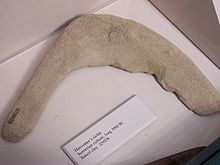
Early people began altering communities of flora and fauna for their own benefit through means such as fire-stick farming and forest gardening very early.[31][32][33] Wild grains have been collected and eaten from at least 105,000 years ago, and possibly much longer.[2] Exact dates are hard to determine, as people collected and ate seeds before domesticating them, and plant characteristics may have changed during this period without human selection. An example is the semi-tough rachis and larger seeds of cereals from just after the Younger Dryas (about 9500 BC) in the early Holocene in the Levant region of the Fertile Crescent. Monophyletic characteristics were attained without any human intervention, implying that apparent domestication of the cereal rachis could have occurred quite naturally.[34]
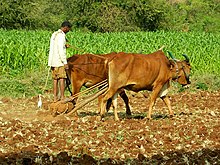
Agriculture began independently in different parts of the globe and included a diverse range of taxa. At least 11 separate regions of the Old and New World were involved as independent centers of origin.[35] Some of the earliest known domestications were of animals. Domestic pigs had multiple centres of origin in Eurasia, including Europe, East Asia and Southwest Asia,[36] where wild boar were first domesticated about 10,500 years ago.[37] Sheep were domesticated in Mesopotamia between 11,000 BC and 9000 BC.[38] Cattle were domesticated from the wild aurochs in the areas of modern Turkey and India around 8500 BC.[39] Camels were domesticated relatively late, perhaps around 3000 BC.[40]
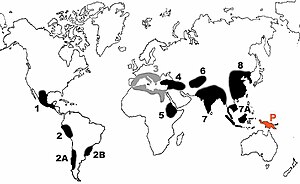
It was not until after 9500 BC that the eight so-called founder crops of agriculture appear: first emmer and einkorn wheat, then hulled barley, peas, lentils, bitter vetch, chick peas and flax. These eight crops occur more or less simultaneously on Pre-Pottery Neolithic B (PPNB) sites in the Levant, although wheat was the first to be grown and harvested on a significant scale.[citation needed][dubious – discuss] At around the same time (9400 BC), parthenocarpic fig trees were domesticated.[42][43]
Domesticated rye occurs in small quantities at some Neolithic sites in (Asia Minor) Turkey, such as the Pre-Pottery Neolithic B (c. 7600 – c. 6000 BC) Can Hasan III near Çatalhöyük,[44] but is otherwise absent until the Bronze Age of central Europe, c. 1800–1500 BC.[45] Claims of much earlier cultivation of rye, at the Epipalaeolithic site of Tell Abu Hureyra in the Euphrates valley of northern Syria, remain controversial.[46] Critics point to inconsistencies in the radiocarbon dates, and identifications based solely on grain, rather than on chaff.[47]
By 8000 BC, farming was entrenched on the banks of the Nile. About this time, agriculture was developed independently in the Far East, probably in China, with rice rather than wheat as the primary crop. Maize was domesticated from the wild grass teosinte in southern Mexico by 6700 BC.[48] The potato (8000 BC), tomato,[49] pepper (4000 BC), squash (8000 BC) and several varieties of bean (8000 BC onwards) were domesticated in the New World.[citation needed]
Agriculture was independently developed on the island of New Guinea.[50] Banana cultivation of Musa acuminata, including hybridization, dates back to 5000 BC, and possibly to 8000 BC, in Papua New Guinea.[51][52]
Bees were kept for honey in the Middle East around 7000 BC.[53] Archaeological evidence from various sites on the Iberian peninsula suggest the domestication of plants and animals between 6000 and 4500 BC.[54] The Céide Fields, located in Ireland consist of extensive tracts of land enclosed by stone walls, these walls date to 3500 BC and is the oldest known field systems in europe.[55][56] The horse was domesticated in the Pontic steppe around 4000 BC In Siberia.[57] Cannabis was in use in China in Neolithic times and may have been domesticated there; it was in use both as a fibre for ropemaking and as a medicine in Ancient Egypt by about 2350 BC.[58]
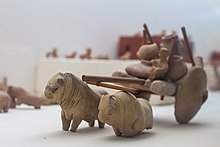
In northern China, millet was domesticated by early Sino-Tibetan speakers at around 8000 to 6000 BC, becoming the main crop of the Yellow River basin by 5500 BC.[59][60] They were followed by mung, soy and azuki beans.
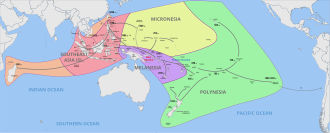
In southern China, rice was domesticated in the Yangtze River basin at around 11,500 to 6200 BC, along with the development of wetland agriculture, by early Austronesian and Hmong-Mien-speakers. Other food plants were also harvested, including acorns, water chestnuts, and foxnuts.[7][59][62][63] Rice cultivation was later spread to Maritime Southeast Asia by the Austronesian expansion, starting at around 3,500 to 2,000 BC. This migration event also saw the introduction of cultivated and domesticated food plants from Taiwan, Maritime Southeast Asia, and New Guinea into the Pacific Islands as canoe plants. Contact with Sri Lanka and Southern India by Austronesian sailors also led to an exchange of food plants which later became the origin of the valuable spice trade.[64][65][66] In the 1st millennium AD, Austronesian sailors also settled Madagascar and the Comoros, bringing Southeast Asian and South Asian food plants with them to the East African coast, including bananas and rice.[67][68] Rice was also spread southwards into Mainland Southeast Asia by around 2000 to 1500 BC by the migrations of the early Austroasiatic and Kra-Dai-speakers.[62]
In the Sahel region of Africa, sorghum was domesticated by 3000 BC in Sudan[69] and pearl millet by 2500 BC in Mali.[70] Kola nut and coffee were also domesticated in Africa.[71] In New Guinea, ancient Papuan peoples began practicing agriculture around 7000 BC, domesticating sugarcane and taro.[72] In the Indus Valley from the eighth millennium BC onwards at Mehrgarh, 2-row and 6-row barley were cultivated, along with einkorn, emmer, and durum wheats, and dates. In the earliest levels of Merhgarh, wild game such as gazelle, swamp deer, blackbuck, chital, wild ass, wild goat, wild sheep, boar, and nilgai were all hunted for food. These are successively replaced by domesticated sheep, goats, and humped zebu cattle by the fifth millennium BC, indicating the gradual transition from hunting and gathering to agriculture.[73]
Maize and squash were domesticated in Mesoamerica; potatoes in South America, and sunflowers in the Eastern Woodlands of North America.[74]
Civilizations
[edit]Sumer
[edit]
Sumerian farmers grew the cereals barley and wheat, starting to live in villages from about 8000 BC. Given the low rainfall of the region, agriculture relied on the Tigris and Euphrates rivers. Irrigation canals leading from the rivers permitted the growth of cereals in large enough quantities to support cities. The first ploughs appear in pictographs from Uruk around 3000 BC; seed-ploughs that funneled seed into the ploughed furrow appear on seals around 2300 BC. Vegetable crops included chickpeas, lentils, peas, beans, onions, garlic, lettuce, leeks and mustard. They grew fruits including dates, grapes, apples, melons, and figs. Alongside their farming, Sumerians also caught fish and hunted fowl and gazelle. The meat of sheep, goats, cows and poultry was eaten, mainly by the elite. Fish was preserved by drying, salting and smoking.[75][76]
Ancient Egypt
[edit]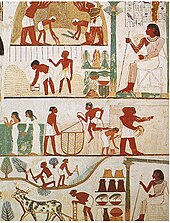
The civilization of Ancient Egypt was indebted to the Nile River and its dependable seasonal flooding. The river's predictability and the fertile soil allowed the Egyptians to build an empire on the basis of great agricultural wealth. Egyptians were among the first peoples to practice agriculture on a large scale, starting in the pre-dynastic period from the end of the Paleolithic into the Neolithic, between around 10,000 BC and 4000 BC.[77] This was made possible with the development of basin irrigation.[78] Their staple food crops were grains such as wheat and barley, alongside industrial crops such as flax and papyrus.[77] Archaeological evidence also suggests that the spread of agriculture in Egypt was facilitated by farming communities associated with the playa lakes of the Sahara some 6,500 years ago.[79]
Indian Subcontinent
[edit]Jujube was domesticated in the Indian subcontinent by 9000 BC.[80] Barley and wheat cultivation – along with the domestication of cattle, primarily sheep and goats – followed in Mehrgarh culture by 8000–6000 BC.[81][82][83] This period also saw the first domestication of the elephant.[80] Pastoral farming in India included threshing, planting crops in rows – either of two or of six – and storing grain in granaries.[82][84] Cotton was cultivated by the 5th–4th millennium BC.[85] By the 5th millennium BC, agricultural communities became widespread in Kashmir.[82] Irrigation was developed in the Indus Valley Civilisation by around 4500 BC.[86] The size and prosperity of the Indus civilization grew as a result of this innovation, leading to more thoroughly planned settlements which used drainage and sewers.[86] Archeological evidence of an animal-drawn plough dates back to 2500 BC in the Indus Valley Civilization.[87]
Ancient China
[edit]
Records from the Warring States, Qin dynasty, and Han dynasty provide a picture of early Chinese agriculture from the 5th century BC to 2nd century AD which included a nationwide granary system and widespread use of sericulture. An important early Chinese book on agriculture is the Qimin Yaoshu of AD 535, written by Jia Sixie.[88] Jia's writing style was straightforward and lucid relative to the elaborate and allusive writing typical of the time. Jia's book was also very long, with over one hundred thousand written Chinese characters, and it quoted many other Chinese books that were written previously, but no longer survive.[89] The contents of Jia's 6th century book include sections on land preparation, seeding, cultivation, orchard management, forestry, and animal husbandry. The book also includes peripherally related content covering trade and culinary uses for crops.[90] The work and the style in which it was written proved influential on later Chinese agronomists, such as Wang Zhen and his groundbreaking Nong Shu of 1313.[89]
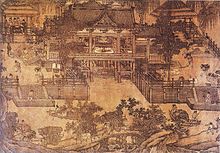
For agricultural purposes, the Chinese had innovated the hydraulic-powered trip hammer by the 1st century BC.[91] Although it found other purposes, its main function to pound, decorticate, and polish grain that otherwise would have been done manually. The Chinese also began using the square-pallet chain pump by the 1st century AD, powered by a waterwheel or oxen pulling an on a system of mechanical wheels.[92] Although the chain pump found use in public works of providing water for urban and palatial pipe systems,[93] it was used largely to lift water from a lower to higher elevation in filling irrigation canals and channels for farmland.[94] By the end of the Han dynasty in the late 2nd century, heavy ploughs had been developed with iron ploughshares and mouldboards.[95][96] These slowly spread west, revolutionizing farming in Northern Europe by the 10th century. (Thomas Glick, however, argues for a development of the Chinese plough as late as the 9th century, implying its spread east from similar designs known in Italy by the 7th century.)[97]
Asian rice was domesticated 8,200–13,500 years ago in China, with a single genetic origin from the wild rice Oryza rufipogon,[7] in the Pearl River valley region of China. Rice cultivation then spread to South and Southeast Asia.[98]
Ancient Greece and Hellenistic world
[edit]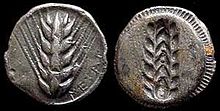
The major cereal crops of the ancient Mediterranean region were wheat, emmer, and barley, while common vegetables included peas, beans, fava, and olives, dairy products came mostly from sheep and goats, and meat, which was consumed on rare occasion for most people, usually consisted of pork, beef, and lamb.[99] Agriculture in ancient Greece was hindered by the topography of mainland Greece that only allowed for roughly 10% of the land to be cultivated properly, necessitating the specialised exportation of oil and wine and importation of grains from Thrace (centered in what is now Bulgaria) and the Greek colonies of Pontic Greeks near the Black Sea. During the Hellenistic period, the Ptolemaic Empire controlled Egypt, Cyprus, Phoenicia, and Cyrenaica, major grain-producing regions that mainland Greeks depended on for subsistence, while the Ptolemaic grain market also played a critical role in the rise of the Roman Republic. In the Seleucid Empire, Mesopotamia was a crucial area for the production of wheat, while nomadic animal husbandry was also practiced in other parts.[100]
Roman Empire
[edit]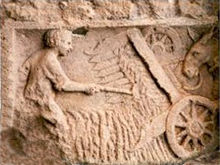
In the Greco-Roman world of Classical antiquity, Roman agriculture was built on techniques originally pioneered by the Sumerians, transmitted to them by subsequent cultures, with a specific emphasis on the cultivation of crops for trade and export. The Romans laid the groundwork for the manorial economic system, involving serfdom, which flourished in the Middle Ages. The farm sizes in Rome can be divided into three categories. Small farms were from 18 to 88 iugera (one iugerum is equal to about 0.65 acre). Medium-sized farms were from 80 to 500 iugera (singular iugerum). Large estates (called latifundia) were over 500 iugera. The Romans had four systems of farm management: direct work by the owner and his family; slaves doing work under the supervision of slave managers; tenant farming or sharecropping in which the owner and a tenant divide up a farm's produce; and situations in which a farm was leased to a tenant.[101]
The Americas
[edit]Agricultural history took a different path from the Old World as the Americas lacked large-seeded, easily domesticated grains (such as wheat and barley) and large domestic animals that could be used for agricultural labor. Rather than the practice which developed in the Old World of sowing a field with a single crop, pre-historic American agriculture usually consisted of cultivating many crops close to each other utilizing only hand labor. Moreover, agricultural areas in the Americas lacked the uniformity of the east–west area of Mediterranean and semi-arid climates in southern Europe and southwestern Asia, but instead had a north–south pattern with a variety of different climatic zones in close proximity to each other. This fostered the domestication of many different plants.[102]
At the time of first contact between the Europeans and the Americans, the Europeans practiced "extensive agriculture, based on the plough and draught animals," with tenants under landlords, but also forced labor or slavery, while the Indigenous peoples of the Americas practiced "intensive agriculture, based on human labour."[103] Europeans wanted control of land for the grazing of their livestock and property rights for the control of production. Though they were impressed with the productivity of traditional farming techniques, they saw no connection to their system and were dismissive of Native American practices as "gardening" rather than a commercializable enterprise.[103][104] Due to several thousand years of selective breeding, maize, the hemisphere's most important crop, was more productive than Old World grain crops. Maize produced two and one-half times more calories per acre than wheat and barley.[105]
South America
[edit]

The earliest known areas of possible agriculture in the Americas dating to about 9000 BC are in Colombia, near present-day Pereira, and by the Las Vegas culture in Ecuador on the Santa Elena peninsula. The plants cultivated (or manipulated by humans) were lerén (Calathea allouia), arrowroot (Maranta arundinacea), squash (Cucurbita species), and bottle gourd (Lagenaria siceraria). All are plants of humid climates and their existence at this time on the semi-arid Santa Elena peninsula may be evidence that they were transplanted there from more humid environments.[106][107] In another study, this area of South America was identified as one of the four oldest places of origin for agriculture, along with the Fertile Crescent, China, and Mesoamerica, dated between 6200 BC and 10000 BC.[108] (To facilitate comprehension by readers, Radiocarbon calibrated BP dates in the above sources have been converted to BC.)
In the Andes region, with civilizations including the Inca, the major crop was the potato, domesticated between 8000 and 5000 BC.[109][110][111] Coca, still a major crop to this day, was domesticated in the Andes, as were the peanut, tomato, tobacco, and pineapple.[72] Cotton was domesticated in Peru by 4200 BC.[112][113] Animals were also domesticated, including llamas, alpacas, and guinea pigs.[114] The people of the Inca Empire of South America grew large surpluses of food which they stored in buildings called Qullqas.[115]
The most important crop domesticated in the Amazon Basin and tropical lowlands was probably cassava, (Manihot esculenta), which was domesticated before 7000 BCE, likely in the Rondônia and Mato Grosso states of Brazil.[116] The Guaitecas Archipelago in modern Chile was the southern limit of Pre-Hispanic agriculture near 44° South latitude,[117] as noted by the mention of the cultivation of Chiloé potatoes by a Spanish expedition in 1557.[118]
Mesoamerica
[edit]
In Mesoamerica, wild teosinte was transformed through human selection into the ancestor of modern maize, about 7,000 BC. It gradually spread across North America and to South America and was the most important crop of Native Americans at the time of European exploration.[119] Other Mesoamerican crops include hundreds of varieties of locally domesticated squash and beans, while cocoa, also domesticated in the region, was a major crop.[72] The turkey, one of the most important poultry birds, was probably domesticated in Mexico or the U.S. Southwest.[120]
In Mesoamerica, the Aztecs were active farmers and had an agriculturally focused economy. The land around Lake Texcoco was fertile, but not large enough to produce the amount of food needed for the population of their expanding empire. The Aztecs developed irrigation systems, formed terraced hillsides, fertilized their soil, and developed chinampas or artificial islands, also known as "floating gardens". The Mayas between 400 BC to 900 AD used extensive canal and raised field systems to farm swampland on the Yucatán Peninsula.[121][122]
North America
[edit]
The indigenous people of the Eastern U.S. domesticated numerous crops. Sunflowers, tobacco,[123] varieties of squash and Chenopodium, as well as crops no longer grown, including marsh elder and little barley.[124][125] Wild foods including wild rice and maple sugar were harvested.[126] The domesticated strawberry is a hybrid of a Chilean and a North American species, developed by breeding in Europe and North America.[127] Two major crops, pecans and Concord grapes, were used extensively in prehistoric times but do not appear to have been domesticated until the 19th century.[128][129]
The indigenous people in what is now California and the Pacific Northwest practiced various forms of forest gardening and fire-stick farming in the forests, grasslands, mixed woodlands, and wetlands, ensuring that desired food and medicine plants continued to be available. The natives controlled fire on a regional scale to create a low-intensity fire ecology which prevented larger, catastrophic fires and sustained a low-density agriculture in loose rotation; a sort of "wild" permaculture.[130][131][132][133]
A system of companion planting called the Three Sisters was developed in North America. Three crops that complemented each other were planted together: winter squash, maize (corn), and climbing beans (typically tepary beans or common beans). The maize provides a structure for the beans to climb, eliminating the need for poles. The beans provide the nitrogen to the soil that the other plants use, and the squash spreads along the ground, blocking the sunlight, helping prevent the establishment of weeds. The squash leaves also act as a "living mulch".[134][135]
Sub-Saharan Africa
[edit]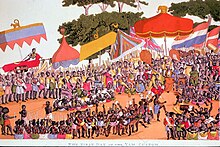
In the Sahel region, civilizations such as the Mali and Songhai empires cultivated sorghum and pearl millet, which were domesticated between 3000 and 2500 BC.[69][70] The donkey was domesticated in Nubia at approximately 5000 BC.[136][137] Archaeological evidence suggests that Sanga cattle may have been independently domesticated in East Africa at around 1600 BC.[138]
In the tropical region of West Africa, crops such as black-eyed peas, Sea Island red peas, yams, kola nuts, Jollof rice and kokoro were domesticated between 3000 and 1000 BC.[71] The coastal region of West Africa is often referred to as the "Yam Belt", due to its high production of yams.[139] The guineafowl is a poultry bird that was domesticated in West Africa, and while the time of the guineafowl's domestication remains unclear, there is evidence that it was present in Ancient Greece during the 5th century BC.[140]
Several species of coffee were also domesticated throughout Sub-Saharan Africa, with Coffea arabica originating in Ethiopia and serving as the main production of modern-day coffee since the late 15th century.[141]
Oceania
[edit]Australia
[edit]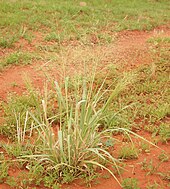
Indigenous Australians were predominately nomadic hunter-gatherers. Due to the policy of terra nullius, Aboriginals were regarded as not having been capable of sustained agriculture. However, the current consensus is that various agricultural methods were employed by the indigenous people.[24][142][25]
In two regions of Central Australia, the central west coast and eastern central Australia, forms of agriculture were practiced. People living in permanent settlements of over 200 residents sowed or planted on a large scale and stored the harvested food. The Nhanda and Amangu of the central west coast grew yams (Dioscorea hastifolia), while various groups in eastern central Australia (the Corners Region) planted and harvested bush onions (yaua – Cyperus bulbosus), native millet (cooly, tindil – Panicum decompositum) and a sporocarp, ngardu (Marsilea drummondii).[31]: 281–304 [28]
Indigenous Australians used systematic burning, fire-stick farming, to enhance natural productivity.[143] In the 1970s and 1980s archaeological research in south west Victoria established that the Gunditjmara and other groups had developed sophisticated eel farming and fish trapping systems over a period of nearly 5,000 years.[144] The archaeologist Harry Lourandos suggested in the 1980s that there was evidence of 'intensification' in progress across Australia,[145] a process that appeared to have continued through the preceding 5,000 years. These concepts led the historian Bill Gammage to argue that in effect the whole continent was a managed landscape.[31]
Torres Strait Islanders are now known to have planted bananas.[25]
Pacific Islands
[edit]In New Guinea, archaeological evidence suggests that agriculture independently emerged around 7,000 years ago with the domestication of crops such as bananas and taro. Pigs and chickens were imported to New Guinea, which were later innovated by other Pacific Island nations, such as those in Polynesia.[146]
Middle Ages and Early Modern period
[edit]Europe
[edit]The Middle Ages saw further improvements in agriculture. Monasteries spread throughout Europe and became important centers for the collection of knowledge related to agriculture and forestry. The manorial system allowed large landowners to control their land and its laborers, in the form of peasants or serfs.[147] During the medieval period, the Arab world was critical in the exchange of crops and technology between the European, Asia and African continents. Besides transporting numerous crops, they introduced the concept of summer irrigation to Europe and developed the beginnings of the plantation system of sugarcane growing through the use of slaves for intensive cultivation.[148]
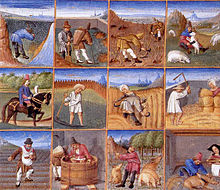
By AD 900, developments in iron smelting allowed for increased production in Europe, leading to developments in the production of agricultural implements such as ploughs, hand tools and horse shoes. The carruca heavy plough improved on the earlier scratch plough, with the adoption of the Chinese mouldboard plough to turn over the heavy, wet soils of northern Europe. This led to the clearing of northern European forests and an increase in agricultural production, which in turn led to an increase in population.[149][150] At the same time, some farmers in Europe moved from a two field crop rotation to a three-field crop rotation in which one field of three was left fallow every year. This resulted in increased productivity and nutrition, as the change in rotations permitted nitrogen-fixing legumes such as peas, lentils and beans.[151] Improved horse harnesses and the whippletree further improved cultivation.[152]
Watermills were introduced by the Romans, but were improved throughout the Middle Ages, along with windmills, and used to grind grains into flour, to cut wood and to process flax and wool.[153]
Crops included wheat, rye, barley and oats. Peas, beans, and vetches became common from the 13th century onward as a fodder crop for animals and also for their nitrogen-fixation fertilizing properties. Crop yields peaked in the 13th century, and stayed more or less steady until the 18th century.[154] Though the limitations of medieval farming were once thought to have provided a ceiling for the population growth in the Middle Ages, recent studies have shown that the technology of medieval agriculture was always sufficient for the needs of the people under normal circumstances,[155][156] and that it was only during exceptionally harsh times, such as the terrible weather of 1315–17, that the needs of the population could not be met.[157][158]
Arab world
[edit]
From the 8th century to the 14th century, the Islamic world underwent a transformation in agricultural practice, described by the historian Andrew Watson as the Arab agricultural revolution.[159] This transformation was driven by a number of factors including the diffusion of many crops and plants along Muslim trade routes, the spread of more advanced farming techniques, and an agricultural-economic system which promoted increased yields and efficiency. The shift in agricultural practice changed the economy, population distribution, vegetation cover, agricultural production, population levels, urban growth, the distribution of the labour force, cooking, diet, and clothing across the Islamic world. Muslim traders covered much of the Old World, and trade enabled the diffusion of many crops, plants and farming techniques across the region, as well as the adaptation of crops, plants and techniques from beyond the Islamic world.[159] This diffusion introduced major crops to Europe by way of Al-Andalus, along with the techniques for their cultivation and cuisine. Sugar cane, rice, and cotton were among the major crops transferred, along with citrus and other fruit trees, nut trees, vegetables such as aubergine, spinach and chard, and the use of imported spices such as cumin, coriander, nutmeg and cinnamon. Intensive irrigation, crop rotation, and agricultural manuals were widely adopted. Irrigation, partly based on Roman technology, made use of noria water wheels, water mills, dams and reservoirs.[159][160][161]
Columbian exchange
[edit]After 1492, a global exchange of previously local crops and livestock breeds occurred. Maize, potatoes, sweet potatoes and manioc were the key crops that spread from the New World to the Old, while varieties of wheat, barley, rice and turnips traveled from the Old World to the New. There had been few livestock species in the New World, with horses, cattle, sheep and goats being completely unknown before their arrival with Old World settlers. Crops moving in both directions across the Atlantic Ocean caused population growth around the world and a lasting effect on many cultures in the Early Modern period.[162]
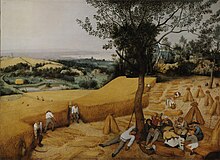
Maize and cassava were introduced from Brazil into Africa by Portuguese traders in the 16th century,[163] becoming staple foods, replacing native African crops.[164] After its introduction from South America to Spain in the late 1500s, the potato became a staple crop throughout Europe by the late 1700s. The potato allowed farmers to produce more food, and initially added variety to the European diet. The increased supply of food reduced disease, increased births and reduced mortality, causing a population boom throughout the British Empire, the US and Europe.[165] The introduction of the potato also brought about the first intensive use of fertilizer, in the form of guano imported to Europe from Peru, and the first artificial pesticide, in the form of an arsenic compound used to fight Colorado potato beetles. Before the adoption of the potato as a major crop, the dependence on grain had caused repetitive regional and national famines when the crops failed, including 17 major famines in England between 1523 and 1623. The resulting dependence on the potato however caused the European Potato Failure, a disastrous crop failure from disease that resulted in widespread famine and the death of over one million people in Ireland alone.[166]
Modern agriculture
[edit]British agricultural revolution
[edit]
Between the 17th century and the mid-19th century, Britain saw a large increase in agricultural productivity and net output. New agricultural practices like enclosure, mechanization, four-field crop rotation to maintain soil nutrients, and selective breeding enabled an unprecedented population growth to 5.7 million in 1750, freeing up a significant percentage of the workforce, and thereby helped drive the Industrial Revolution. The productivity of wheat went up from 19 US bushels (670 L; 150 US dry gal; 150 imp gal) per acre in 1720 to around 30 US bushels (1,100 L; 240 US dry gal; 230 imp gal) by 1840, marking a major turning point in history.[167]
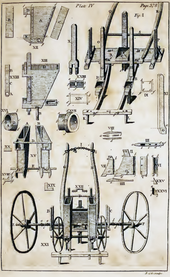
Advice on more productive techniques for farming began to appear in England in the mid-17th century, from writers such as Samuel Hartlib, Walter Blith and others.[168] The main problem in sustaining agriculture in one place for a long time was the depletion of nutrients, most importantly nitrogen levels, in the soil. To allow the soil to regenerate, productive land was often let fallow and, in some places, crop rotation was used. The Dutch four-field rotation system was popularised by the British agriculturist Charles Townshend in the 18th century. The system (wheat, turnips, barley and clover) opened up a fodder crop and grazing crop allowing livestock to be bred year-round. The use of clover was especially important as the legume roots replenished soil nitrates.[169] The mechanisation and rationalisation of agriculture was another important factor. Robert Bakewell and Thomas Coke introduced selective breeding and initiated a process of inbreeding to maximise desirable traits from the mid 18th century, such as the New Leicester sheep. Machines were invented to improve the efficiency of various agricultural operation, such as Jethro Tull's seed drill of 1701 that mechanised seeding at the correct depth and spacing and Andrew Meikle's threshing machine of 1784. Ploughs were steadily improved, from Joseph Foljambe's Rotherham iron plough in 1730[170] to James Small's improved "Scots Plough" metal in 1763. In 1789 Ransomes, Sims & Jefferies was producing 86 plough models for different soils.[171] Powered farm machinery began with Richard Trevithick's stationary steam engine, used to drive a threshing machine, in 1812.[172] Mechanisation spread to additional farm uses throughout the 19th century. The first petrol-driven tractor was built in America by John Froelich in 1892.[173]
John Bennet Lawes began the scientific investigation of fertilization at the Rothamsted Experimental Station in 1843. He investigated the impact of inorganic and organic fertilizers on crop yield and founded one of the first artificial fertilizer manufacturing factories in 1842. Fertilizer, in the shape of sodium nitrate deposits in Chile, was imported to Britain by John Thomas North as well as guano (birds droppings). The first commercial process for fertilizer production was the obtaining of phosphate from the dissolution of coprolites in sulphuric acid.[174]
20th century
[edit]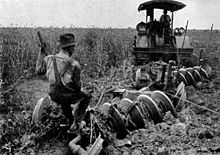
Dan Albone constructed the first commercially successful gasoline-powered general-purpose tractor in 1901, and the 1923 International Harvester Farmall tractor marked a major point in the replacement of draft animals (particularly horses) with machines. Since that time, self-propelled mechanical harvesters (combines), planters, transplanters and other equipment have been developed, further revolutionizing agriculture.[175] These inventions allowed farming tasks to be done with a speed and on a scale previously impossible, leading modern farms to output much greater volumes of high-quality produce per land unit.[176]
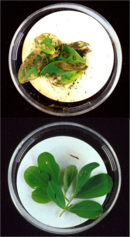
The Haber-Bosch method for synthesizing ammonium nitrate represented a major breakthrough and allowed crop yields to overcome previous constraints. It was first patented by German chemist Fritz Haber. In 1910 Carl Bosch, while working for German chemical company BASF, successfully commercialized the process and secured further patents. In the years after World War II, the use of synthetic fertilizer increased rapidly, in sync with the increasing world population.[178]
Collective farming was widely practiced in the Soviet Union, the Eastern Bloc countries, China, and Vietnam, starting in the 1930s in the Soviet Union; one result was the Soviet famine of 1932–33.[179] Another consequence occurred during the Great Leap Forward in China initiated by Mao Tse-tung that resulted in the Great Chinese Famine from 1959 to 1961 and ultimately reshaped the thinking of Deng Xiaoping.
In the past century agriculture has been characterized by increased productivity, the substitution of synthetic fertilizers and pesticides for labour, water pollution,[180] and farm subsidies.[181] Other applications of scientific research since 1950 in agriculture include gene manipulation,[182][183] hydroponics,[184] and the development of economically viable biofuels such as ethanol.[185]
The number of people involved in farming in industrial countries fell radically from 24 percent of the American population to 1.5 percent in 2002. The number of farms also decreased, and their ownership became more concentrated; for example, between 1967 and 2002, one million pig farms in America consolidated into 114,000, with 80 percent of the production on factory farms.[186] According to the Worldwatch Institute, 74 percent of the world's poultry, 43 percent of beef, and 68 percent of eggs are produced this way.[186][187]
Famines however continued to sweep the globe through the 20th century. Through the effects of climatic events, government policy, war and crop failure, millions of people died in each of at least ten famines between the 1920s and the 1990s.[188]
Green Revolution
[edit]
The Green Revolution was a series of research, development, and technology transfer initiatives between the 1940s and the late 1970s. It increased agriculture production around the world, especially from the late 1960s. The initiatives, led by Norman Borlaug and credited with saving over a billion people from starvation, involved the development of high-yielding varieties of cereal grains, expansion of irrigation infrastructure, modernization of management techniques, distribution of hybridized seeds, synthetic fertilizers, and pesticides to farmers.[189]
Synthetic nitrogen, mined rock phosphate, pesticides, and mechanization have greatly increased crop yields in the early 20th century. Increased supply of grains has also led to cheaper livestock. Further, global yield increases were experienced later in the 20th century when high-yield varieties of common staple grains such as rice, wheat, and corn were introduced as a part of the Green Revolution. The Green Revolution exported the technologies (including pesticides and synthetic nitrogen) of the developed world to the developing world. Thomas Malthus famously predicted that the Earth would not be able to support its growing population. Still, technologies such as the Green Revolution have allowed the world to produce a food surplus.[190]
Although the Green Revolution significantly increased rice yields in Asia, yield leveled off. The genetic "yield potential" has increased for wheat, but the yield potential for rice has not increased since 1966, and the yield potential for maize has "barely increased in 35 years". It takes only a decade or two for herbicide-resistant weeds to emerge, and insects become resistant to insecticides within about a decade, delayed somewhat by crop rotation.[191]
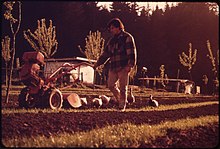
Organic agriculture
[edit]For most of its history, agriculture has been organic, without synthetic fertilisers or pesticides, and without GMOs. With the advent of chemical agriculture, Rudolf Steiner called for farming without synthetic pesticides, and his Agriculture Course of 1924 laid the foundation for biodynamic agriculture.[192] Lord Northbourne developed these ideas and presented his manifesto of organic farming in 1940. This became a worldwide movement, and organic farming is now practiced in many countries.[193]
See also
[edit]References
[edit]- ^ a b c "The Development of Agriculture". National Geographic. 2022-07-08. Archived from the original on 2023-01-30. Retrieved 2023-01-30.
- ^ a b Mercader, J. (December 2009). "Mozambican grass seed consumption during the Middle Stone Age". Science. 326 (5960): 1680–1683. Bibcode:2009Sci...326.1680M. doi:10.1126/science.1173966. PMID 20019285. S2CID 44865552.
- ^ Snir, Ainit (2015). "The Origin of Cultivation and Proto-Weeds, Long before Neolithic Farming". PLOS ONE. 10 (7): e0131422. Bibcode:2015PLoSO..1031422S. doi:10.1371/journal.pone.0131422. PMC 4511808. PMID 26200895.
- ^ Zeder, Melinda (October 2011). "The Origins of Agriculture in the Near East". Current Anthropology. 52 (S4): 221–235. doi:10.1086/659307. JSTOR 10.1086/659307. S2CID 8202907.
- ^ Hirst, Kris (June 2019). "Domestication History of Rye". ThoughtCo. Retrieved 18 April 2020.
- ^ Seabra, Luís; Teira-Brión, Andrés; López-Dóriga, Inés; Martín-Seijo, María; Almeida, Rubim; Tereso, João Pedro (10 May 2023). "The introduction and spread of rye (Secale cereale) in the Iberian Peninsula". PLOS ONE. 18 (5): e0284222. Bibcode:2023PLoSO..1884222S. doi:10.1371/journal.pone.0284222. PMC 10171662. PMID 37163473.
- ^ a b c Molina, J.; Sikora, M.; Garud, N.; Flowers, J. M.; Rubinstein, S.; Reynolds, A.; Huang, P.; Jackson, S.; Schaal, B. A.; Bustamante, C. D.; Boyko, A. R.; Purugganan, M. D. (2011). "Molecular evidence for a single evolutionary origin of domesticated rice". Proceedings of the National Academy of Sciences. 108 (20): 8351–6. Bibcode:2011PNAS..108.8351M. doi:10.1073/pnas.1104686108. PMC 3101000. PMID 21536870.
- ^ a b Choi, Jae Young; Zaidem, Maricris; Gutaker, Rafal; Dorph, Katherine; Singh, Rakesh Kumar; Purugganan, Michael D. (2019-03-07). "The complex geography of domestication of the African rice Oryza glaberrima". PLOS Genetics. 15 (3): e1007414. doi:10.1371/journal.pgen.1007414. ISSN 1553-7404. PMC 6424484. PMID 30845217.
- ^ a b Cubry, Philippe; Tranchant-Dubreuil, Christine; Thuillet, Anne-Céline; Monat, Cécile; Ndjiondjop, Marie-Noelle; Labadie, Karine; Cruaud, Corinne; Engelen, Stefan; Scarcelli, Nora; Rhoné, Bénédicte; Burgarella, Concetta (2018-07-23). "The Rise and Fall of African Rice Cultivation Revealed by Analysis of 246 New Genomes". Current Biology. 28 (14): 2274–2282.e6. Bibcode:2018CBio...28E2274C. doi:10.1016/j.cub.2018.05.066. ISSN 0960-9822. PMID 29983312. S2CID 51600014.
- ^ Winchell, Frank; Brass, Michael; Manzo, Andrea; Beldados, Alemseged; Perna, Valentina; Murphy, Charlene; Stevens, Chris; Fuller, Dorian Q. (2018). "On the Origins and Dissemination of Domesticated Sorghum and Pearl Millet across Africa and into India: a View from the Butana Group of the Far Eastern Sahel". The African Archaeological Review. 35 (4): 483–505. doi:10.1007/s10437-018-9314-2. ISSN 0263-0338. PMC 6394749. PMID 30880862.
- ^ Manning, Katie; Pelling, Ruth; Higham, Tom; Schwenniger, Jean-Luc; Fuller, Dorian Q. (2011-02-01). "4500-Year old domesticated pearl millet (Pennisetum glaucum) from the Tilemsi Valley, Mali: new insights into an alternative cereal domestication pathway". Journal of Archaeological Science. 38 (2): 312–322. Bibcode:2011JArSc..38..312M. doi:10.1016/j.jas.2010.09.007. ISSN 0305-4403.
- ^ Scarcelli, Nora; Cubry, Philippe; Akakpo, Roland; Thuillet, Anne-Céline; Obidiegwu, Jude; Baco, Mohamed N.; Otoo, Emmanuel; Sonké, Bonaventure; Dansi, Alexandre; Djedatin, Gustave; Mariac, Cédric (2019-05-03). "Yam genomics supports West Africa as a major cradle of crop domestication". Science Advances. 5 (5): eaaw1947. Bibcode:2019SciA....5.1947S. doi:10.1126/sciadv.aaw1947. ISSN 2375-2548. PMC 6527260. PMID 31114806.
- ^ Herniter, Ira A.; Muñoz-Amatriaín, María; Close, Timothy J. (December 2020). "Genetic, textual, and archeological evidence of the historical global spread of cowpea ( Vigna unguiculata [L.] Walp.)". Legume Science. 2 (4). doi:10.1002/leg3.57. ISSN 2639-6181. S2CID 220516241.
- ^ Edward, Sue B. (1991), Hawkes, J. G.; Engels, J. M. M.; Worede, M. (eds.), "Crops with wild relatives found in Ethiopia", Plant Genetic Resources of Ethiopia, Cambridge: Cambridge University Press, pp. 42–74, ISBN 978-0-521-38456-8, retrieved 2022-08-09
- ^ "Finger Millet". Crop Wild Relatives. Retrieved 2022-08-09.
- ^ "Plant studies show where Africa's early farmers tamed some of the continent's key crops". science.org. Retrieved 2022-08-09.
- ^ "Why It's Difficult to Chart Banana History". ThoughtCo. Retrieved 2022-08-11.
- ^ "Early Africans Went Bananas". science.org. Retrieved 2022-08-11.
- ^ Shen, Quan-Kuan; Peng, Min-Sheng; Adeola, Adeniyi C; Kui, Ling; et al. (8 June 2021). "Genomic Analyses Unveil Helmeted Guinea Fowl ( Numida meleagris ) Domestication in West Africa". Genome Biology and Evolution. 13 (6). doi:10.1093/gbe/evab090. PMC 8214406. PMID 34009300.
- ^ Pitt, Daniel; Sevane, Natalia; Nicolazzi, Ezequiel L.; MacHugh, David E.; Park, Stephen D. E.; Colli, Licia; Martinez, Rodrigo; Bruford, Michael W.; Orozco-terWengel, Pablo (January 2019). "Domestication of cattle: Two or three events?". Evolutionary Applications. 12 (1): 123–136. Bibcode:2019EvApp..12..123P. doi:10.1111/eva.12674. ISSN 1752-4571. PMC 6304694. PMID 30622640.
- ^ Mwai, Okeyo; Hanotte, Olivier; Kwon, Young-Jun; Cho, Seoae (2015-06-11). "- Invited Review - African Indigenous Cattle: Unique Genetic Resources in a Rapidly Changing World". Asian-Australasian Journal of Animal Sciences. 28 (7): 911–921. doi:10.5713/ajas.15.0002R. ISSN 1011-2367. PMC 4478499. PMID 26104394.
- ^ World Cotton Production, Yara North America
- ^ National Heritage Places – Budj Bim National Heritage Landscape". Australian Government. Dept of the Environment and Energy. 20 July 2004. Retrieved 30 January 2020. See also attached documents: National Heritage List Location and Boundary Map, and Government Gazette, 20 July 2004.
- ^ a b Gammage, Bill (October 2011). The Biggest Estate on Earth: How Aborigines made Australia. Allen & Unwin. pp. 281–304. ISBN 978-1-74237-748-3.
- ^ a b c "Indigenous Australians 'farmed bananas 2,000 years ago'". BBC News. 12 August 2020.
- ^ Stromberg, Joseph (February 2013). "Classical gas". Smithsonian. 43 (10): 18. Archived from the original on 15 October 2013. Retrieved 27 August 2013.
- ^ Hillman, G.C. (1996) "Late Pleistocene changes in wild plant-foods available to hunter-gatherers of the northern Fertile Crescent: Possible preludes to cereal cultivation". In D.R. Harris (ed.) The Origins and Spread of Agriculture and Pastoralism in Eurasia, UCL Books, London, pp. 159–203; Sato, Y. (2003) "Origin of rice cultivation in the Yangtze River basin". In Y. Yasuda (ed.) The Origins of Pottery and Agriculture, Roli Books, New Delhi, p. 196
- ^ a b Gerritsen, R. (2008). Australia and the Origins of Agriculture. Archaeopress. pp. 29–30.
- ^ "Climate". National Climate Data Center. Retrieved 1 December 2013.
- ^ Gavashelishvili, A; et al. (2023), "The time and place of origin of South Caucasian languages: insights into past human societies, ecosystems and human population genetics", Scientific Reports, 13 (21133): 21133, Bibcode:2023NatSR..1321133G, doi:10.1038/s41598-023-45500-w, PMC 10689496, PMID 38036582
- ^ a b c Gammage, Bill (October 2011). The Biggest Estate on Earth: How Aborigines made Australia. Allen & Unwin. ISBN 978-1-74237-748-3.
- ^ Douglas John McConnell (2003). The Forest Farms of Kandy: And Other Gardens of Complete Design. Ashgate. p. 1. ISBN 978-0-7546-0958-2.
- ^ McConnell, Douglas John (1992). The forest-garden farms of Kandy, Sri Lanka. Food & Agriculture Org. p. 1. ISBN 978-92-5-102898-8.
- ^ Allaby, Robin G.; Fuller, Dorian Q.; Brown, Terence A. (2008). "The genetic expectations of a protracted model for the origins of domesticated crops". Proceedings of the National Academy of Sciences. 105 (37): 13982–13986. Bibcode:2008PNAS..10513982A. doi:10.1073/pnas.0803780105. PMC 2544565. PMID 18768818.
- ^ Larson, G.; Piperno, D.R.; Allaby, R.G.; Purugganan, M.D.; Andersson, L.; Arroyo-Kalin, M.; Barton, L.; Climer Vigueira, C.; Denham, T.; Dobney, K.; Doust, A.N.; Gepts, P.; Gilbert, M.T.P.; Gremillion, K.J.; Lucas, L.; Lukens, L.; Marshall, F.B.; Olsen, K.M.; Pires, J.C.; Richerson, P.J.; Rubio De Casas, R.; Sanjur, O.I.; Thomas, M.G.; Fuller, D.Q. (2014). "Current perspectives and the future of domestication studies". Proceedings of the National Academy of Sciences. 111 (17): 6139–46. Bibcode:2014PNAS..111.6139L. doi:10.1073/pnas.1323964111. PMC 4035915. PMID 24757054.
- ^ Larson, Greger; Dobney, Keith; Albarella, Umberto; Fang, Meiying; Matisoo-Smith, Elizabeth; Robins, Judith; Lowden, Stewart; Finlayson, Heather; Brand, Tina (2005-03-11). "Worldwide Phylogeography of Wild Boar Reveals Multiple Centers of Pig Domestication". Science. 307 (5715): 1618–1621. Bibcode:2005Sci...307.1618L. doi:10.1126/science.1106927. PMID 15761152. S2CID 39923483.
- ^ Larson, Greger; Albarella, Umberto; Dobney, Keith; Rowley-Conwy, Peter; Schibler, Jörg; Tresset, Anne; Vigne, Jean-Denis; Edwards, Ceiridwen J.; Schlumbaum, Angela (2007-09-25). "Ancient DNA, pig domestication, and the spread of the Neolithic into Europe". Proceedings of the National Academy of Sciences. 104 (39): 15276–15281. Bibcode:2007PNAS..10415276L. doi:10.1073/pnas.0703411104. PMC 1976408. PMID 17855556.
- ^ Ensminger, M.E.; Parker, R.O. (1986). Sheep and Goat Science (Fifth ed.). Interstate Printers and Publishers. ISBN 978-0-8134-2464-4.
- ^ McTavish, E.J.; Decker, J.E.; Schnabel, R.D.; Taylor, J.F.; Hillis, D.M. (2013). "New World cattle show ancestry from multiple independent domestication events". PNAS. 110 (15): 1398–406. Bibcode:2013PNAS..110E1398M. doi:10.1073/pnas.1303367110. PMC 3625352. PMID 23530234.
- ^ Sapir-Hen, Lidar; Ben-Yosef, Erez (2013). "The Introduction of Domestic Camels to the Southern Levant: Evidence from the Aravah Valley" (PDF). Tel Aviv. 40 (2): 277–285. doi:10.1179/033443513x13753505864089. S2CID 44282748.
- ^ Ladizinsky, G. (1998). Plant Evolution under Domestication. Kluwer. ISBN 978-0-412-82210-0.
- ^ Kislev, M. E. (2006). "Early Domesticated Fig in the Jordan Valley". Science. 312 (5778): 1372–1374. Bibcode:2006Sci...312.1372K. doi:10.1126/science.1125910. PMID 16741119. S2CID 42150441.
- ^ Lev-Yadun, S. (2006). "Comment on "Early Domesticated Fig in the Jordan Valley"". Science. 314 (5806): 1683a. Bibcode:2006Sci...314.1683L. doi:10.1126/science.1132636. PMID 17170278.
- ^ Hillman, Gordon (1978). "On the Origins of Domestic rye: Secale Cereale: The Finds from Aceramic Can Hasan III in Turkey". Anatolian Studies. 28: 157–174. doi:10.2307/3642748. JSTOR 3642748. S2CID 85225244. – via JSTOR (subscription required)
- ^ Zohary, Daniel; Hopf, Maria; Weiss, Ehud (2012). Domestication of Plants in the Old World: The Origin and Spread of Domesticated Plants in Southwest Asia, Europe, and the Mediterranean Basin. Oxford: Oxford University Press. p. 62. ISBN 978-0-19-954906-1 – via Google Books.
- ^ Hillman, Gordon; Hedges, Robert; Moore, Andrew; Colledge, Susan; Pettitt, Paul (2001). "New evidence of Lateglacial cereal cultivation at Abu Hureyra on the Euphrates". The Holocene. 11 (4): 383–393. Bibcode:2001Holoc..11..383H. doi:10.1191/095968301678302823. S2CID 84930632.
- ^ Colledge, Sue; Conolly, James (2010). "Reassessing the evidence for the cultivation of wild crops during the Younger Dryas at Tell Abu Hureyra, Syria". Environmental Archaeology. 15 (2): 124–138. Bibcode:2010EnvAr..15..124C. doi:10.1179/146141010X12640787648504. S2CID 129087203.
- ^ Dolores, R.; Piperno, Anthony J.; Ranere, Irene Holst; Iriarte, Jose; Dickau, Ruth (2009). "Starch grain and phytolith evidence for early ninth millennium B.P. maize from the Central Balsas River Valley, Mexico". PNAS. 106 (13): 5019–5024. Bibcode:2009PNAS..106.5019P. doi:10.1073/pnas.0812525106. PMC 2664021. PMID 19307570.
- ^ Smith, A.F. (1994). The Tomato in America: Early History, Culture, and Cookery. University of South Carolina Press. p. 13. ISBN 978-1-57003-000-0.
- ^ Denham, T.P. (2003). "Origins of Agriculture at Kuk Swamp in the Highlands of New Guinea" (PDF). Science. 301 (5630): 189–193. doi:10.1126/science.1085255. PMID 12817084. S2CID 10644185.
- ^ Nelson, S.C.; Ploetz, R.C.; Kepler, A.K. (2006). "Musa species (bananas and plantains)" (PDF). In Elevitch, C.R. (ed.). Species Profiles for Pacific Island Agroforestry. Hōlualoa, Hawaiʻi: Permanent Agriculture Resources.
- ^ Denham, T.P.; Haberle, S.G.; Lentfer, C.; Fullagar, R.; Field, J.; Therin, M.; Porch, N.; Winsborough, B. (2003). "Origins of Agriculture at Kuk Swamp in the Highlands of New Guinea" (PDF). Science. 301 (5630): 189–193. doi:10.1126/science.1085255. PMID 12817084. S2CID 10644185.
- ^ Roffet-Salque, Mélanie; Regert, Martine; Evershed, Richard P.; et al. (2015). "Widespread exploitation of the honeybee by early Neolithic farmers". Nature. 527 (7577): 226–230. Bibcode:2015Natur.527..226R. doi:10.1038/nature15757. hdl:10379/13692. PMID 26560301. S2CID 205246432.
- ^ "Southern Europe, 8000–2000 B.C. Timeline of Art History". The Metropolitan Museum of Art. Archived from the original on 26 January 2007. Retrieved 2011-07-16.
- ^ "Ceide Fields Visitor Centre, Ballycastle, County Mayo, West of Ireland". Museums of Mayo. Archived from the original on 22 July 2011. Retrieved 16 July 2011.
- ^ "The Céide Fields and North West Mayo Boglands". UNESCO World Heritage Centre. Archived from the original on Oct 17, 2011. Retrieved 16 July 2011.
- ^ Anthony, David W. (2007). The Horse, the Wheel, and Language: How Bronze-Age Riders from the Eurasian Steppes Shaped the Modern World. Princeton University Press.
- ^ Vergara, Daniela (2 December 2014). "Cannabis: Marijuana, hemp and its cultural history". Cannabis Genomics. Archived from the original on 9 April 2016. Retrieved 20 June 2016.
- ^ a b He, Keyang; Lu, Houyuan; Zhang, Jianping; Wang, Can; Huan, Xiujia (7 June 2017). "Prehistoric evolution of the dualistic structure mixed rice and millet farming in China". The Holocene. 27 (12): 1885–1898. Bibcode:2017Holoc..27.1885H. doi:10.1177/0959683617708455. S2CID 133660098.
- ^ Lu, H.; Zhang, J.; Liu, K.B.; Wu, N.; Li, Y.; Zhou, K.; Ye, M.; Zhang, T.; et al. (2009). "Earliest domestication of common millet (Panicum miliaceum) in East Asia extended to 10,000 years ago". Proceedings of the National Academy of Sciences of the United States of America. 106 (18): 7367–7372. Bibcode:2009PNAS..106.7367L. doi:10.1073/pnas.0900158106. PMC 2678631. PMID 19383791.
- ^ Chambers, Geoff (2013). "Genetics and the Origins of the Polynesians". eLS. John Wiley & Sons, Inc. doi:10.1002/9780470015902.a0020808.pub2. ISBN 978-0-470-01617-6.
- ^ a b Bellwood, Peter (9 December 2011). "The Checkered Prehistory of Rice Movement Southwards as a Domesticated Cereal—from the Yangzi to the Equator" (PDF). Rice. 4 (3–4): 93–103. Bibcode:2011Rice....4...93B. doi:10.1007/s12284-011-9068-9. S2CID 44675525.
- ^ Hsieh, Jaw-shu; Hsing, Yue-ie Caroline; Hsu, Tze-fu; Li, Paul Jen-kuei; Li, Kuang-ti; Tsang, Cheng-hwa (24 December 2011). "Studies on Ancient Rice—Where Botanists, Agronomists, Archeologists, Linguists, and Ethnologists Meet". Rice. 4 (3–4): 178–183. Bibcode:2011Rice....4..178H. doi:10.1007/s12284-011-9075-x.
- ^ Gilboa, Ayelet; Namdar, Dvory (9 February 2016). "On the Beginnings of South Asian Spice Trade with the Mediterranean Region: A Review". Radiocarbon. 57 (2): 265–283. doi:10.2458/azu_rc.57.18562. S2CID 55719842.
- ^ Zumbroich, Thomas J. (2007–2008). "The origin and diffusion of betel chewing: a synthesis of evidence from South Asia, Southeast Asia and beyond". eJournal of Indian Medicine. 1: 87–140.
- ^ Mahdi, Waruno (1999). "The Dispersal of Austronesian boat forms in the Indian Ocean". In Blench, Roger; Spriggs, Matthew (eds.). Archaeology and Language III: Artefacts languages, and texts. One World Archaeology. Vol. 34. Routledge. pp. 144–179. ISBN 978-0-415-10054-0.
- ^ Beaujard, Philippe (August 2011). "The first migrants to Madagascar and their introduction of plants: linguistic and ethnological evidence" (PDF). Azania: Archaeological Research in Africa. 46 (2): 169–189. doi:10.1080/0067270X.2011.580142. S2CID 55763047.
- ^ Walter, Annie; Lebot, Vincent (2007). Gardens of Oceania. IRD Éditions-CIRAD. ISBN 978-1-86320-470-5.
- ^ a b Winchell, Frank (October 2017). "Evidence for Sorghum Domestication in Fourth Millennium BC Eastern Sudan: Spikelet Morphology from Ceramic Impressions of the Butana Group" (PDF). Current Anthropology. 58 (5): 673–683. doi:10.1086/693898. S2CID 149402650.
- ^ a b Manning, Katie (February 2011). "4500-Year old domesticated pearl millet (Pennisetum glaucum) from the Tilemsi Valley, Mali: new insights into an alternative cereal domestication pathway". Journal of Archaeological Science. 38 (2): 312–322. Bibcode:2011JArSc..38..312M. doi:10.1016/j.jas.2010.09.007 – via Elsevier Science Direct.
- ^ a b Carney, Judith (2011). "Food and the African Past". In the Shadow of Slavery: Africa's Botanical Legacy in the Atlantic World. University of California Press. p. 24. ISBN 978-0-520-94953-9.
- ^ a b c Murphy, Denis (2011). Plants, Biotechnology and Agriculture. CABI. pp. 153–. ISBN 978-1-84593-913-7.
- ^ Barker, Graeme (2009). The Agricultural Revolution in Prehistory: Why Did Foragers Become Farmers?. Oxford University Press. pp. 159–161. ISBN 978-0-19-955995-4.
- ^ Anderson, David; Goudie, Andrew; Parker, Adrian (2013). Global Environments Through the Quaternary: Exploring Environmental Change. Oxford University Press. p. 283. ISBN 978-0-19-969726-7.
- ^ "Farming". British Museum. Archived from the original on 16 June 2016. Retrieved 15 June 2016.
- ^ Tannahill, Reay (1968). The fine art of food. Folio Society.
- ^ a b Janick, Jules (2002). "Ancient Egyptian Agriculture and the Origins of Horticulture" (PDF). Acta Hort. 583 (582): 23–39. doi:10.17660/ActaHortic.2002.582.1.
- ^ Kees, Herman (1961). Ancient Egypt: A Cultural Topography. University of Chicago Press. ISBN 978-0-226-42914-4.
- ^ Jack, R. Harlan (2006-05-18). "Indigenous African Agriculture". The Origins of Agriculture: An International Perspective (New ed.). Tuscaloosa: University of Alabama Press. pp. 59–71. ISBN 0-8173-5349-6.
- ^ a b Gupta, Anil K (10 July 2004). "Origin of agriculture and domestication of plants and animals linked to early Holocene climate amelioration". Current Science. 87 (1). Indian Academy of Sciences: 58–59.
- ^ Baber, Zaheer (1996). The Science of Empire: Scientific Knowledge, Civilization, and Colonial Rule in India. State University of New York Press. p. 19. ISBN 978-0-7914-2919-8.
- ^ a b c Harris, David R.; Gosden, C. (1996). The Origins and Spread of Agriculture and Pastoralism in Eurasia: Crops, Fields, Flocks And Herds. Routledge. p. 385. ISBN 978-1-85728-538-3.
- ^ Wright, Rita P (2009). The Ancient Indus: Urbanism, Economy, and Society. Cambridge University Press. pp. 44, 51. ISBN 978-0-521-57652-9.
- ^ Possehl, Gregory L. (1996). Mehrgarh in Oxford Companion to Archaeology, edited by Brian Fagan. Oxford University Press.
- ^ Stein, Burton (1998). A History of India. Blackwell Publishing. 47. ISBN 0-631-20546-2.
- ^ a b Rodda & Ubertini (2004). The Basis of Civilization – Water Science?. International Association of Hydrological Science. p. 279. ISBN 978-1-901502-57-2.
- ^ Lal, R. (2001). "Thematic evolution of ISTRO: transition in scientific issues and research focus from 1955 to 2000". Soil and Tillage Research. 61 (1–2): 3–12 [3]. Bibcode:2001STilR..61....3L. doi:10.1016/S0167-1987(01)00184-2.
- ^ Needham, Joseph (1986). Science and Civilization in China: Volume 6, Part 2. Taipei: Caves Books Ltd. pp. 55–56.
- ^ a b Needham, Volume 6, Part 2, 56.
- ^ Needham, Volume 6, Part 2, 57.
- ^ Needham, Joseph (1986). Science and Civilization in China: Volume 4, Physics and Physical Technology, Part 2, Mechanical Engineering. Taipei: Caves Books, Ltd. p. 184
- ^ Needham, Volume 4, Part 2, 89, 110.
- ^ Needham, Volume 4, Part 2, 33.
- ^ Needham, Volume 4, Part 2, 110.
- ^ Robert Greenberger, The Technology of Ancient China, Rosen Publishing Group, 2006, pp. 11–12.
- ^ Wang Zhongshu, trans. by K.C. Chang and Collaborators, Han Civilization (New Haven and London: Yale University Press, 1982).
- ^ Glick, Thomas F. (2005). Medieval Science, Technology And Medicine: An Encyclopedia. Volume 11 of The Routledge Encyclopedias of the Middle Ages Series. Psychology Press. p. 270. ISBN 978-0-415-96930-7.
- ^ Huang, Xuehui; Kurata, Nori; Wei, Xinghua; Wang, Zi-Xuan; Wang, Ahong; Zhao, Qiang; Zhao, Yan; Liu, Kunyan; et al. (2012). "A map of rice genome variation reveals the origin of cultivated rice". Nature. 490 (7421): 497–501. Bibcode:2012Natur.490..497H. doi:10.1038/nature11532. PMC 7518720. PMID 23034647.
- ^ Koester, Helmut (1995), History, Culture, and Religion of the Hellenistic Age, 2nd edition, New York: Walter de Gruyter, ISBN 3-11-014693-2, pp. 76–77.
- ^ Helmut Koester (1995), History, Culture, and Religion of the Hellenistic Age, 2nd edition, New York: Walter de Gruyter, ISBN 3-11-014693-2, p. 77.
- ^ White, K. D. (1970), Roman Farming (Cornell University Press)
- ^ Diamond, Jared (1999). Guns, Germs, and Steel (Paperback ed.). New York: W.W. Norton. pp. 123–128, 134–142. ISBN 0-393-31755-2.
- ^ a b Sempat Assadourian, Carlos (1992). "The Colonial Economy; The Transfer of the European System of Production to New Spain and Peru". Journal of Latin American Studies. 24 (Quincentenary Supplement): 62. JSTOR 156945.
- ^ Hill, Christina Gish (24 November 2020). "Returning Corn, Beans, and Squash to Native American Farms". JSTOR Daily. JSTOR. Retrieved 9 July 2021.
- ^ Ensminger, Marion Eugene; Ensminger, Audrey H. (1994). Food & Nutrition Encyclopedia. London: CRC-Press. p. 1104.
- ^ Zarrillo, S.; Pearsall, D. M.; Tisdale, M. A.; Quon, D. J. (2008). "Directly dated starch residues document early formative maize (Zea mays L.) in tropical Ecuador". Proceedings of the National Academy of Sciences of the United States of America. 105 (13): 5006–5011. Bibcode:2008PNAS..105.5006Z. doi:10.1073/pnas.0800894105. PMC 2278185. PMID 18362336.
- ^ Piperno, Dolores R. (2011). "The Origin of Plant Cultivation and Domestication in the New World Tropics: Pattern, Process, and New Developments". Current Anthropology. 52 (S-4): S453–S470. doi:10.1086/659998. S2CID 83061925.
- ^ Larson, Gregor (29 April 2014). "Current Perspectives and the Future of Domestication Studies". Proceedings of the National Academy of Sciences. 111 (17): 6139–6146. Bibcode:2014PNAS..111.6139L. doi:10.1073/pnas.1323964111. PMC 4035915. PMID 24757054.
- ^ Spooner, David M.; McLean, Karen; Ramsay, Gavin; Waugh, Robbie; Bryan, Glenn J. (2005). "A single domestication for potato based on multilocus amplified fragment length polymorphism genotyping". PNAS. 102 (41): 14694–14699. Bibcode:2005PNAS..10214694S. doi:10.1073/pnas.0507400102. PMC 1253605. PMID 16203994.
- ^ Office of International Affairs (1989). Lost Crops of the Incas: Little-Known Plants of the Andes with Promise for Worldwide Cultivation. p. 92. doi:10.17226/1398. ISBN 978-0-309-04264-2 – via nap.edu.
- ^ John Michael Francis (2005). Iberia and the Americas. ABC-CLIO. ISBN 978-1-85109-426-4.
- ^ Rajpal, Vijay Rani (2016). Gene Pool Diversity and Crop Improvement, Volume 1. Springer. p. 117. ISBN 978-3-319-27096-8. Retrieved 9 April 2016.
- ^ Broudy, Eric (1979). The Book of Looms: A History of the Handloom from Ancient Times to the Present. UPNE. p. 81. ISBN 978-0-87451-649-4.
- ^ Rischkowsky, Barbara; Pilling, Dafydd (2007). The State of the World's Animal Genetic Resources for Food and Agriculture. Food & Agriculture Organization. p. 10. ISBN 978-92-5-105762-9.
- ^ Mumford, Jeremy Ravi (2012). Vertical Empire. Durham, NC: Duke University Press. pp. 15, 27. ISBN 978-0-8223-5310-2.
- ^ Isendahl, Christian (December 2011). "The Domestication and Early Spread of Manioc". Latin American Antiquity. 22 (4): 464. doi:10.7183/1045-6635.22.4.452. JSTOR 23072569. S2CID 161372308.
- ^ Bird, Junius (1946). "The Alacaluf". In Steward, Julian H. (ed.). Handbook of South American Indians. Bulletin 143. Vol. I. –Bureau of American Ethnology. pp. 55–79.
- ^ Contreras, Andrés; Ciampi, Luigi; Padulosi, Stefano; Spooner, David M. (1993). "Potato germplasm collecting expedition to the Guaitecas and Chonos Archipelagos, Chile, 1990". Potato Research. 36 (4): 309–316. doi:10.1007/BF02361797. S2CID 6759459. Archived from the original on 2020-08-01. Retrieved 2019-01-11.
- ^ Johannessen, S.; Hastorf, C.A. (eds.). Corn and Culture in the Prehistoric New World. Westview Press.
- ^ Speller, Camilla F.; et al. (2010). "Ancient mitochondrial DNA analysis reveals complexity of indigenous North American turkey domestication". PNAS. 107 (7): 2807–2812. Bibcode:2010PNAS..107.2807S. doi:10.1073/pnas.0909724107. PMC 2840336. PMID 20133614.
- ^ Mascarelli, Amanda (5 November 2010). "Mayans converted wetlands to farmland". Nature. doi:10.1038/news.2010.587.
- ^ Morgan, John (2012-11-06). "Invisible Artifacts: Uncovering Secrets of Ancient Maya Agriculture with Modern Soil Science" (pdf). Soil Horizons. 53 (6). Madison, Illinois: Soil Science Society of America: 3–6. doi:10.2136/sh2012-53-6-lf (inactive 2024-11-01). ISSN 2163-2812. OCLC 8561599813. Archived from the original on 2020-07-28.
{{cite journal}}: CS1 maint: DOI inactive as of November 2024 (link) - ^ Heiser, Carl B. Jr. (1992). "On possible sources of the tobacco of prehistoric Eastern North America". Current Anthropology. 33: 54–56. doi:10.1086/204032. S2CID 144433864.
- ^ Prehistoric Food Production in North America, edited by Richard I. Ford. Museum of Anthropology, University of Michigan, Anthropological Papers 75.
- ^ Adair, Mary J. (1988) Prehistoric Agriculture in the Central Plains. Publications in Anthropology 16. University of Kansas, Lawrence.
- ^ Smith, Andrew (2013). The Oxford Encyclopedia of Food and Drink in America. OUP US. pp. 1–. ISBN 978-0-19-973496-2.
- ^ Hardigan, Michael A. "P0653: Domestication History of Strawberry: Population Bottlenecks and Restructuring of Genetic Diversity through Time". Pland & Animal Genome Conference XXVI January 13–17, 2018 San Diego, California. Retrieved 28 February 2018.
- ^ "Pecans at Texas A&M University". Pecankernel.tamu.edu. 2006-08-18. Archived from the original on 2010-05-25. Retrieved 2010-06-03.
- ^ The History of Concord Grapes, http://www.concordgrape.org/bodyhistory.html
- ^ Sugihara, Neil G.; Jan W. Van Wagtendonk; Shaffer, Kevin E.; Fites-Kaufman, Joann; Thode, Andrea E., eds. (2006). "17". Fire in California's Ecosystems. University of California Press. p. 417. ISBN 978-0-520-24605-8.
- ^ Blackburn, Thomas C. and Kat Anderson, ed. (1993). Before the Wilderness: Environmental Management by Native Californians. Ballena Press. ISBN 978-0-87919-126-9.
- ^ Cunningham, Laura (2010). State of Change: Forgotten Landscapes of California. Heyday. pp. 135, 173–202. ISBN 978-1-59714-136-9.
- ^ Anderson, M. Kat (2006). Tending the Wild: Native American Knowledge And the Management of California's Natural Resources. University of California Press. ISBN 978-0-520-24851-9.
- ^ Wilson, Gilbert (1917). Agriculture of the Hidatsa Indians: An Indian Interpretation. Dodo Press. pp. 25 and passim. ISBN 978-1-4099-4233-7. Archived from the original on 14 March 2016.
- ^ Landon, Amanda J. (2008). "The "How" of the Three Sisters: The Origins of Agriculture in Mesoamerica and the Human Niche". Nebraska Anthropologist. University of Nebraska-Lincoln: 110–124.
- ^ Beja-Pereira, Albano; et al. (18 June 2004). "African Origins of the Domestic Donkey". Science. 304 (1781): 1781. doi:10.1126/science.1096008. PMID 15205528. S2CID 12783335.
- ^ Roger Blench, "The history and spread of donkeys in Africa" (PDF). (235 KB)
- ^ Grigson, Caroline (1991). "An African origin for African cattle? — some archaeological evidence". The African Archaeological Review. 9 (1): 119–144. doi:10.1007/BF01117218. S2CID 162307756.
- ^ "Celebrating Nigeria's yummy yams". BBC News. 2010-09-22. Retrieved 2023-11-15.
- ^ Blench, Roger; MacDonald, Kevin C. (1999). The Origins and Development of African Livestock. London: UCL. p. 10. ISBN 978-1-84142-018-9.
- ^ Weinberg, Bennett Alan; Bealer, Bonnie K. (2001). The World of Caffeine: The Science and Culture of the World's Most Popular Drug. Psychology Press. pp. 3–4. ISBN 978-0-415-92723-9.
- ^ Dark Emu
- ^ Jones, R. (1969). "Fire-stick Farming". Australian Natural History. 16: 224.
- ^ Williams, E. (1988) Complex Hunter-Gatherers: A Late Holocene Example from Temperate Australia. British Archaeological Reports, Oxford
- ^ Lourandos, H. (1997) Continent of Hunter-Gatherers: New Perspectives in Australian Prehistory Cambridge University Press, Cambridge
- ^ Bourke, R. Michael (2009), "History of agriculture in Papua New Guinea", in Bourke, R. Michael; Harwood, Tracy (eds.), Food and Agriculture in Papua New Guinea, Australian National University Press, pp. 10–26, ISBN 978-1-921536-60-1, JSTOR j.ctt24h987.12
- ^ Jourdan, Pablo. "Medieval Horticulture/Agriculture". Ohio State University. Archived from the original on 14 April 2013. Retrieved 24 April 2013.
- ^ Janick, Jules (2008). "Islamic Influences on Western Agriculture" (PDF). Purdue University. Retrieved 2013-05-23.
- ^ White, Lynn (1967). "The Life of the Silent Majority". In Hoyt, Robert S. (ed.). Life and Thought in the Early Middle Ages. University of Minnesota Press. p. 88.
- ^ Andersen, Thomas Barnebeck; Jensen, Peter Sandholt; Skovsgaard, Christian Volmar (December 2014). "The Heavy Plough and the Agricultural Revolution in Medieval Europe" (PDF). European Historical Economics Society. Archived from the original (PDF) on 2016-08-18. Retrieved 2017-04-05.
- ^ Fox, H.S.A. (November 1986). "The Alleged Transformation from Two-Field to Three-Field Systems in Medieval England". The Economic History Review. 39 (4): 526–548. doi:10.1111/j.1468-0289.1986.tb01255.x. JSTOR 2596482.
- ^ White, Lynn Townsend (1978). Medieval Religion and Technology: Collected Essays. University of California Press. p. 143. ISBN 978-0-520-03566-9.
- ^ Newman, Paul B. (2001). Daily Life in the Middle Ages. McFarland. pp. 88–89. ISBN 978-0-7864-5052-7.
- ^ Campbell, Bruce M.S.; M. Overton (1993). "A New Perspective on Medieval and Early Modern Agriculture: Six Centuries of Norfolk Farming, c.1250-c.1850". Past and Present (141): 38–105. doi:10.1093/past/141.1.38.
- ^ Campbell, Bruce M.S. (2000). English Seigniorial Agriculture, 1250–1450. Cambridge University Press. ISBN 978-0-521-30412-2.
- ^ Stone, David (2005). Decision-Making in Medieval Agriculture. Oxford University Press. ISBN 978-0-19-924776-9.
- ^ Langdon, John (2010). Bjork, Robert E. (ed.). The Oxford Dictionary of the Middle Ages. Oxford University Press. pp. 20–23. ISBN 978-0-19-866262-4.
- ^ Jordan, William Chester (1997). The Great Famine: Northern Europe in the Early Fourteenth Century. Princeton University Press. ISBN 978-1-4008-2213-3.
- ^ a b c Watson, Andrew M. (1974). "The Arab Agricultural Revolution and Its Diffusion, 700–1100". The Journal of Economic History. 34 (1): 8–35. doi:10.1017/s0022050700079602. S2CID 154359726.
- ^ Watson, Andrew M. (1983). Agricultural Innovation in the Early Islamic World. Cambridge University Press. ISBN 978-0-521-24711-5.
- ^ Food Journeys of a Lifetime. National Geographic Society. 2015. pp. 126–. ISBN 978-1-4262-1609-1.
- ^ Crosby, Alfred. "The Columbian Exchange". The Gilder Lehrman Institute of American History. Retrieved 11 May 2013.
- ^ Wagner, Holly. "Super-Sized Cassava Plants May Help Fight Hunger In Africa". The Ohio State University. Archived from the original on 2013-12-08. Retrieved 11 May 2013.
- ^ Wambugu, Florence; Wafula, John, eds. (2000). "Advances in Maize Streak Virus Disease Research in Eastern and Southern Africa". International Service for the Acquisition of Agri-Biotech Applications. Retrieved 16 April 2013.
- ^ Chapman, Jeff (2000). "The Impact of the Potato". History Magazine (2). Archived from the original on 11 May 2000.
- ^ Mann, Charles C. "How the Potato Changed History". Smithsonian (November 2011). Archived from the original on 2013-11-02. Retrieved 2013-11-28. Adapted from 1493: Uncovering the New World Columbus Created, by Charles C. Mann.
- ^ Snell, K.D.M. (1985). Annals of the Labouring Poor, Social Change and Agrarian England 1660–1900. Cambridge University Press. ISBN 978-0-521-24548-7. Chapter 4
- ^ Thirsk, Joan (2004). "Blith, Walter (bap. 1605, d. 1654)". Oxford Dictionary of National Biography (online ed.). Oxford University Press. doi:10.1093/ref:odnb/2655. Retrieved 2 September 2011. (Subscription or UK public library membership required.)
- ^ Harskamp, Jaap (2009). "The Low Countries and the English Agricultural Revolution". Gastronomica. 9 (3): 32–41. doi:10.1525/gfc.2009.9.3.32. JSTOR 10.1525/gfc.2009.9.3.32.
- ^ Payne, F.G. "The British Plough: Some Stages in its Development" (PDF). British Agricultural History Society. Retrieved 5 April 2017.
- ^ Barlow, Robert Stockes (2003). 300 Years of Farm Implements and Machinery 1630–1930. Krause Publications. p. 33. ISBN 978-0-87349-632-2.
- ^ Hodge, James (1973). Richard Trevithick. Shire Publications. p. 30. ISBN 978-0-85263-177-5.
- ^ Macmillan, Don; Broehl, Wayne G. The John Deere Tractor Legacy. Voyageur Press. p. 45. ISBN 978-1-61060-529-8.
- ^ "The Coprolite Industry". Cambridgeshire History. Archived from the original on 4 April 2016. Retrieved 5 April 2017.
- ^ Janick, Jules. "Agricultural Scientific Revolution: Mechanical" (PDF). Purdue University. Retrieved 24 May 2013.
- ^ Reid, John F. (2011). "The Impact of Mechanization on Agriculture". The Bridge on Agriculture and Information Technology. 41 (3).
- ^ Suszkiw, Jan (November 1999). "Tifton, Georgia: A Peanut Pest Showdown". Agricultural Research magazine. Retrieved 23 November 2008.
- ^ "A Historical Perspective". International Fertilizer Industry Association. Archived from the original on 9 March 2012. Retrieved 7 May 2013.
- ^ Iordachi, Constantin; Bauerkamper, Arnd (2014). The Collectivization of Agriculture in Communist Eastern Europe: Comparison and Entanglements. Central European University Press. p. 9. ISBN 978-615-5225-63-5.
- ^ Moss, Brian (2008). "Water Pollution by Agriculture". Phil. Trans. R. Soc. Lond. B. 363 (1491): 659–666. doi:10.1098/rstb.2007.2176. PMC 2610176. PMID 17666391.
- ^ "Title 05 – Agriculture and rural development". Archived from the original on 4 December 2013. Retrieved 16 June 2016.
- ^ James, Clive (1996). "Global Review of the Field Testing and Commercialization of Transgenic Plants: 1986 to 1995" (PDF). The International Service for the Acquisition of Agri-biotech Applications. Retrieved 17 July 2010.
- ^ Weasel, Lisa H. 2009. Food Fray. Amacom Publishing
- ^ Douglas, James S., Hydroponics, 5th ed. Oxford University Press, 1975. 1–3
- ^ "Towards Sustainable Production and Use of Resources: Assessing Biofuels" (PDF). United Nations Environment Programme. 16 October 2009. Archived from the original (PDF) on 22 November 2009. Retrieved 24 October 2009.
- ^ a b Scully, Matthew (2002). Dominion: The Power of Man, the Suffering of Animals, and the Call to Mercy. Macmillan. pp. 26, 29. ISBN 978-0-312-31973-1.
- ^ "State of the World 2006". Worldwatch Institute. 2006.
- ^ "Ten worst famines of the 20th century". Sydney Morning Herald. 15 August 2011.
- ^ Hazell, Peter B.R. (2009). The Asian Green Revolution. IFPRI Discussion Paper. International Food Policy Research Institute. GGKEY:HS2UT4LADZD.
- ^ Barrionuevo, Alexei; Bradsher, Keith (8 December 2005). "Sometimes a Bumper Crop Is Too Much of a Good Thing". The New York Times.
- ^ Tilman, D.; Cassman, K.G.; Matson, P.A.; Naylor, R.; Polasky, S. (August 2002). "Agricultural sustainability and intensive production practices" (PDF). Nature. 418 (6898): 671–677. Bibcode:2002Natur.418..671T. doi:10.1038/nature01014. PMID 12167873. S2CID 3016610. Archived from the original (PDF) on 2011-07-16. Retrieved 2013-11-28.
- ^ Paull, John (2011). "Attending the First Organic Agriculture Course: Rudolf Steiner's Agriculture Course at Koberwitz, 1924" (PDF). European Journal of Social Sciences. 21 (1): 64–70.
- ^ Paull, John (2014). "Lord Northbourne, the man who invented organic farming, a biography" (PDF). Journal of Organic Systems. 9 (1): 31–53.
Further reading
[edit]Surveys
[edit]- Civitello, Linda. Cuisine and Culture: A History of Food and People (Wiley, 2011) excerpt
- Federico, Giovanni. Feeding the World: An Economic History of Agriculture 1800–2000 (Princeton UP, 2005) highly quantitative
- Grew, Raymond. Food in Global History Archived 2011-06-04 at the Wayback Machine (1999)
- Heiser, Charles B. Seed to Civilization: The Story of Food (W.H. Freeman, 1990)
- Herr, Richard, ed. Themes in Rural History of the Western World (Iowa State UP, 1993)
- Kiple, Kenneth F., and Kriemhild Coneè Ornelas, eds. The Cambridge world history of food (2 vol Cambridge University Press, 2000) online.
- Mazoyer, Marcel, and Laurence Roudart. A History of World Agriculture: From the Neolithic Age to the Current Crisis (Monthly Review Press, 2006) Marxist perspective.
- Pilcher, Jeffrey M. Food in world history (Routledge, 2023).
- Prentice, E. Parmalee. Hunger and History: The Influence of Hunger on Human History (Harper, 1939)
- Tauger, Mark. Agriculture in World History (Routledge, 2008)
- Toussaint-Samat, Maguelonne. A history of food ( John Wiley & Sons, 2009), 800+ pp. online
- Whayne, Jeannie. The Oxford Handbook of Agricultural History (2024) excerpt; covers historiographical traditions within geographic regions across the world.
Premodern
[edit]- Bakels, C.C. The Western European Loess Belt: Agrarian History, 5300 BC – AD 1000 (Springer, 2009)
- Barker, Graeme, and Candice Goucher, eds. The Cambridge World History: Volume 2, A World with Agriculture, 12000 BCE–500 CE. (Cambridge UP, 2015)
- Bowman, Alan K. and Rogan, Eugene, eds. Agriculture in Egypt: From Pharaonic to Modern Times (Oxford UP, 1999)
- Cohen, M.N. The Food Crisis in Prehistory: Overpopulation and the Origins of Agriculture (Yale UP, 1977)
- Crummey, Donald and Stewart, C.C., eds. Modes of Production in Africa: The Precolonial Era (Sagem 1981)
- Diamond, Jared. Guns, Germs, and Steel (W.W. Norton, 1997)
- Duncan-Jones, Richard. Economy of the Roman Empire (Cambridge UP, 1982)
- Habib, Irfan. Agrarian System of Mughal India (Oxford UP, 3rd ed. 2013)
- Harris, D.R., ed. The Origins and Spread of Agriculture and Pastoralism in Eurasia, (Routledge, 1996)
- Isager, Signe and Jens Erik Skydsgaard. Ancient Greek Agriculture: An Introduction (Routledge, 1995)
- Lee, Mabel Ping-hua. The economic history of china: with special reference to agriculture (Columbia University, 1921)
- Murray, Jacqueline. The First European Agriculture (Edinburgh UP, 1970)
- Oka, H-I. Origin of Cultivated Rice (Elsevier, 2012)
- Price, T.D. and A. Gebauer, eds. Last Hunters – First Farmers: New Perspectives on the Prehistoric Transition to Agriculture (1995)
- Srivastava, Vinod Chandra, ed. History of Agriculture in India (5 vols., 2014). From 2000 BC to present.
- Stevens, C.E. "Agriculture and Rural Life in the Later Roman Empire" in Cambridge Economic History of Europe, Vol. I, The Agrarian Life of the Middle Ages (Cambridge UP, 1971)
- Teall, John L. (1959). "The grain supply of the Byzantine Empire, 330–1025". Dumbarton Oaks Papers. 13: 87–139. doi:10.2307/1291130. JSTOR 1291130.
- Yasuda, Y., ed. The Origins of Pottery and Agriculture (SAB, 2003)
Modern
[edit]- Collingham, E.M. The Taste of War: World War Two and the Battle for Food (Penguin, 2012)
- Kerridge, Erik. "The Agricultural Revolution Reconsidered." Agricultural History ( 1969) 43:4, 463–475. in JSTOR, in Britain, 1750–1850
- Ludden, David, ed. New Cambridge History of India: An Agrarian History of South Asia Archived 2011-06-04 at the Wayback Machine (Cambridge, 1999).
- McNeill, William H. (1999). "How the Potato Changed the World's History". Social Research. 66 (1): 67–83. JSTOR 40971302. PMID 22416329.
- Manning, Richard (1 February 2005). Against the Grain: How Agriculture Has Hijacked Civilization. Farrar, Straus and Giroux. ISBN 978-1-4668-2342-6.
- Mintz, Sidney. Sweetness and Power: The Place of Sugar in Modern History (Penguin, 1986)
- Reader, John. Propitious Esculent: The Potato in World History (Heinemann, 2008) a standard scholarly history
- Salaman, Redcliffe N. The History and Social Influence of the Potato (Cambridge, 2010)
Europe
[edit]- Ambrosoli, Mauro. The Wild and the Sown: Botany and Agriculture in Western Europe, 1350–1850 (Cambridge UP, 1997)
- Brassley, Paul, Yves Segers, and Leen Van Molle, eds. War, Agriculture, and Food: Rural Europe from the 1930s to the 1950s (Routledge, 2012)
- Brown, Jonathan. Agriculture in England: A Survey of Farming, 1870–1947 (Manchester UP, 1987)
- Clark, Gregory (2007). "The long march of history: Farm wages, population, and economic growth, England 1209–1869" (PDF). Economic History Review. 60 (1): 97–135. doi:10.1111/j.1468-0289.2006.00358.x. S2CID 154325999.
- Dovring, Folke, ed. Land and labor in Europe in the twentieth century: a comparative survey of recent agrarian history (Springer, 1965)
- Gras, Norman. A history of agriculture in Europe and America (Crofts, 1925)
- Harvey, Nigel. The Industrial Archaeology of Farming in England and Wales (HarperCollins, 1980)
- Hoffman, Philip T. Growth in a Traditional Society: The French Countryside, 1450–1815 (Princeton UP, 1996)
- Hoyle, Richard W., ed. The Farmer in England, 1650–1980 (Routledge, 2013) online review[dead link]
- Kussmaul, Ann. A General View of the Rural Economy of England, 1538–1840 (Cambridge University Press, 1990)
- Langdon, John. Horses, Oxen and Technological Innovation: The Use of Draught Animals in English Farming from 1066 to 1500 (Cambridge UP, 1986)
- McNeill, William H. (1948). "The Introduction of the Potato into Ireland". Journal of Modern History. 21 (3): 218–221. doi:10.1086/237272. JSTOR 1876068. S2CID 145099646.
- Moon, David. The Plough that Broke the Steppes: Agriculture and Environment on Russia's Grasslands, 1700–1914 (Oxford UP, 2014)
- Slicher van Bath, B.H. The Agrarian History of Western Europe, AD 500–1850 (Edward Arnold, reprint, 1963)
- Thirsk, Joan, et al. The Agrarian History of England and Wales (Cambridge University Press, 8 vols., 1978)
- Williamson, Tom. Transformation of Rural England: Farming and the Landscape 1700–1870 (Liverpool UP, 2002)
- Zweiniger-Bargielowska, Ina, Rachel Duffett, and Alain Drouard, eds. Food and war in twentieth century Europe (Ashgate, 2011)
North America
[edit]- Bidwell, Percy Wells, and John I. Falconer. History of agriculture in the northern United States, 1620-1860 (1925), massive scholarly history. online
- Cochrane, Willard W. The Development of American Agriculture: A Historical Analysis (University of Minnesota P, 1993)
- Fite, Gilbert C. (1983). "American Farmers: The New Minority". Annals of Iowa. 46 (7): 553–555. doi:10.17077/0003-4827.8923.
- Gras, Norman. A History of Agriculture in Europe and America, (F.S. Crofts, 1925)
- Gray, L.C. History of Agriculture in the Southern United States to 1860 (P. Smith, 1933) Volume I online; Volume 2
- Hart, John Fraser. The Changing Scale of American Agriculture. (University of Virginia Press, 2004)
- Hurt, R. Douglas. American Agriculture: A Brief History (Purdue UP, 2002)
- Mundlak, Yair (2005). "Economic Growth: Lessons from Two Centuries of American Agriculture". Journal of Economic Literature. 43 (4): 989–1024. CiteSeerX 10.1.1.582.8537. doi:10.1257/002205105775362005.
- O'Sullivan, Robin. American Organic: A Cultural History of Farming, Gardening, Shopping, and Eating (University Press of Kansas, 2015)
- Rasmussen, Wayne D., ed. Readings in the history of American agriculture (University of Illinois Press, 1960)
- Robert, Joseph C. The story of tobacco in America (University of North Carolina Press, 1949)
- Russell, Howard. A Long Deep Furrow: Three Centuries of Farming In New England (UP of New England, 1981)
- Russell, Peter A. How Agriculture Made Canada: Farming in the Nineteenth Century (McGill-Queen's UP, 2012)
- Schafer, Joseph. The social history of American agriculture (Da Capo, 1970 [1936])
- Schlebecker John T. Whereby we thrive: A history of American farming, 1607–1972 (Iowa State UP, 1972)
- Weeden, William Babcock. Economic and Social History of New England, 1620–1789 (Houghton, Mifflin, 1891)
